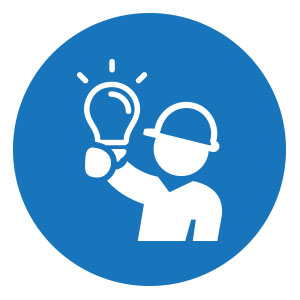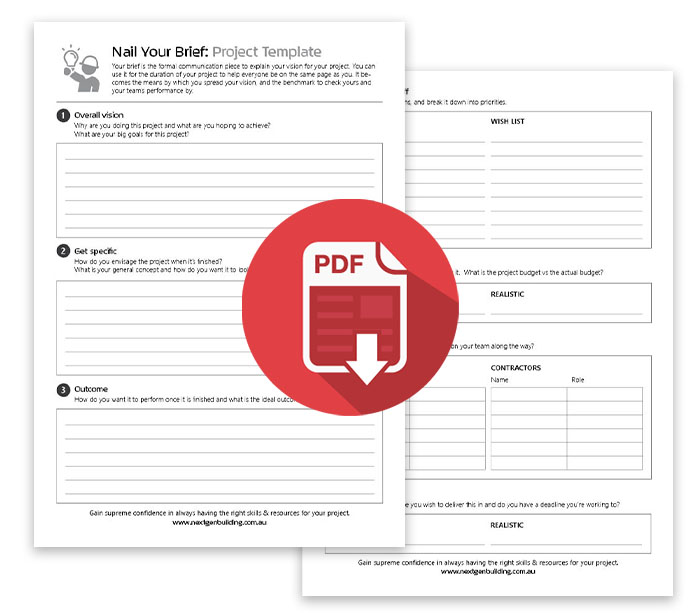
 |
Nail Your Brief: Free Project TemplateDownload and print this free template which will guide you through the process of nailing your Project Brief. |
Next Video: Communication Tool 3: Communicate Using The Right Language
So G’day and welcome back to our second video in our series where we’re talking about the importance of Communication and we’re going through some ideas that I’ve come up with that would help to assist in your Project running a lot more smoothly. So, the second point we’re going to talk about today is about nailing your brief.
So, what is a brief? A brief is a Communication piece that is used to explain your vision for the Project. The brief can be used throughout the entire duration of your Project and it becomes a benchmark which you can use to measure not only your Team’s performance but also your own performance as you go along.
So, realistically what you say and write in your brief, becomes very crucial to make sure that it is clear to you first and once it is clear to you and you understand what you’re trying to achieve then you can go about explaining it to the rest of your Team Members. But ultimately what you need to make sure is what you say and mean in your brief, is what your Team Members hear and understand - this is very critical because it can bring everything undone, if there’s a loss of Communication or translation in that aspect.
How do we get clear on our brief? Well I’ve come up with seven questions that I think you should probably ask yourself prior to starting any Project and we’re just about to go through and we’ll talk about them in a minute. Let’s quickly go through these seven questions and see if we can get an understanding of how by asking these questions to Ourselves before we start the job, it will assist us in producing a better brief for our Project so we can communicate that to our Team.
1. “What’s your overall vision for the job – why are you doing it and what are you hoping the outcome is going to be?”
2. “Once the Project’s done, how do you want it to perform?”
So what I mean by that is, if you’re building say a shed for example, do you know if you want the shed there for a workshop? Do you want it to be a Granny Flat in the future? You know, what are you trying to get out of the job?
3. “How do you want it to essentially look, feel, taste, touch, all that sort of thing when it’s done?”
Do you want it made out of Colorbond? Do you want it made out of Matrix Panel? It doesn’t have to be essentially related to the design but ultimately what’s it going to look like when it’s finished and that will obviously tie into at the end of the day how it will perform, so they sort of work together.
4. This is where we’ll get it down to a bit more of a practical side of things. So you should make two lists for every job. The two lists will be what are your “must haves” in that job and what are your “wish list” items.
So to break that down and to get a little bit of understanding of what I mean there is, everyone has a Project where we’re doing a bathroom renovation for example. Everyone must have a shower, because if you don’t have a shower you don’t have a bathroom but the wish list item might be we want to put heated towel rails in. If the budget permits, the Builder can go through and say “Hey listen we’ve come up and we’ve been able to save some money in this area and we’ve ticked off all your must have items. Would you like to try and squeeze in some of your wish list items without affecting your budget too much?”That’s just one example and you can apply that to whatever Project you are working on. Be that a Mining job, it might be a Commercial job.
5. This relates to your budget – no matter what Project you are doing, there will always be two budgets. Project budget and Actual budget.
Project budget is what you want the job to cost and the Actual budget is, if I had to push tooth and nail and sell my arm what could I stretch myself to?
The reason we have the two budgets is because it ties back into your must have’s and your wish list items. So if we know what sort of budgets you are working around, there’s an element of trust there where you say well the Builder is not going to rip me off by quoting too much (and I really hope that never happens) but when you know your Project budget we can come to you and say “hey, listen we can fit these wish list items in and it won’t change your budget too much”. There is also the actual budget where you can say “potentially I could sell that arm and have that heated towel rail”
6. How are you going to build this? who’s going to get around you to help you with it?
What materials are you going to use? And going back to the Team that’s going to work alongside you?
Remember we talked about in video one, where we discussed how we can effectively choose a team that can really work along with you and get you, understand what you’re trying to do – work with you and not against you. If you forgot about that or didn’t hear about it, just drop a link in the comments below or below this video and you can go back and refresh your memory or catch up on that (Video one of this series)
7. What time frame are you working with?
Do you have time constraints that you’re confined between? Do you have an open-ended time frame?
You need to be clear of what your objective is and what you are trying to do with this time. How long is it going to take? Be very open with your Builder too as he can give you insight into how long things take realistically. Sometimes there’s a bit of misunderstanding about how long things should take vs how long things do take. Have those questions in your mind.
We are coming to the end of this video so a couple more things :-
Putting pictures in your brief can be really helpful.Jump on Social Media platforms, Google images. Ask your Builder if they can provide any photos or plans of past Projects they have worked on to help you get a better understanding and feel for what you are hoping to achieve. Don’t be afraid to ask the question. Don’t be afraid to get creative.
The final key point I want to really drive home to finish this video is – it is essential that you are clear on what you’re trying to do, why you’re trying to do it and how you’re going to do it before you try and communicate that to the rest of your Team. Until you really understand why you’re doing it, how you’re going to do it and all of that, it will be really hard to get that communicated to your Team.
So that’s it, thanks so much for sticking with us for another video. I’m Mitch from Next Gen Building and just keep an eye out for the third video in this series.
Next Video: Communication Tool 3: Communicate Using The Right Language
« Return to 7 Essential Project Communication Tools: Video Series